-
During class time I'll be on Zoom, at
https://nku.zoom.us/j/7057440907.
- An important word on Pass/Fail from
our chair, Dr. Buckley.
- I highlight, in bold, the important piece which the university isn't highlighting in the FAQ for students....
- Our Last week:
- Today, Wednesday: How we might simulate a time series, like
temperatures, based off the variogram.
- Friday: Review for the final
- Today, Wednesday: How we might simulate a time series, like
temperatures, based off the variogram.
- No new homework.
- Sorry, neither have I graded your old homework. I'll talk about
the models, however, so you'll know how you did.
- Last time we looked at spatial autocorrelation, in the form of
this thing called a "variogram". The variogram tells us that weather is
correlated, day by day.
We model that correlation using the "empirical variogram" (a temporal decomposition of the sample variance), constructing something we call the "theoretical variogram".
We find roughly the same thing for our data, especially after having removed the trend (which you should have calculated for homework) for the two time series:
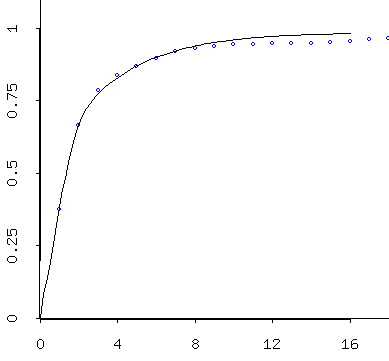
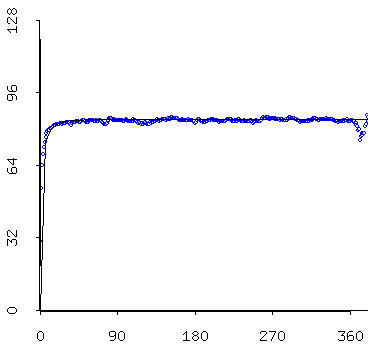
At left: zooming in on the nose of the graph at right. The "empirical variogram" and the "theoretical variogram for the residuals of the minimum temperature model (after we've removed your models). I mentioned last time that we want to render our data "stationary" before we simulate. In order to do that, we need to take care of some issues in our mins and maxes: their fluxuating means and standard deviations.
When I talk about their means and standard deviations, these refer to the distribution of values we see for each day of the year over 127 years or so of BG weather. Consider August 15th, for example, and the minima. If we plot them for the 127 years, we see a distribution like this:

Empirical PDF -- Probability Density Function -- for August 15th Minima with a suggested normal-distribution overlay. Maybe the data isn't normal, but that's just to give you the idea.
For each day we have a mean minimum, and a standard deviation of the minima. So those are the values that were plotted above, for the whole year.
We might want to create a theoretical distribution from the empirical data -- otherwise we'd never be able to exceed the extremes of the data (to "create new records").
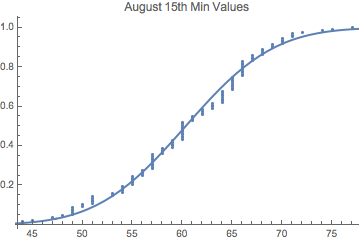
Empirical CDF -- Cumulative Distribution Function -- for August 15th Minima with a normal cdf overlay (I just used the mean and the standard deviation of the empirical data to estimate the normal). Maybe the data isn't normal, but this is just to give you the idea.
By the way, for the randomin
If we look at the distribution of means and standard deviations of these temperatures across the year, over 127 years:
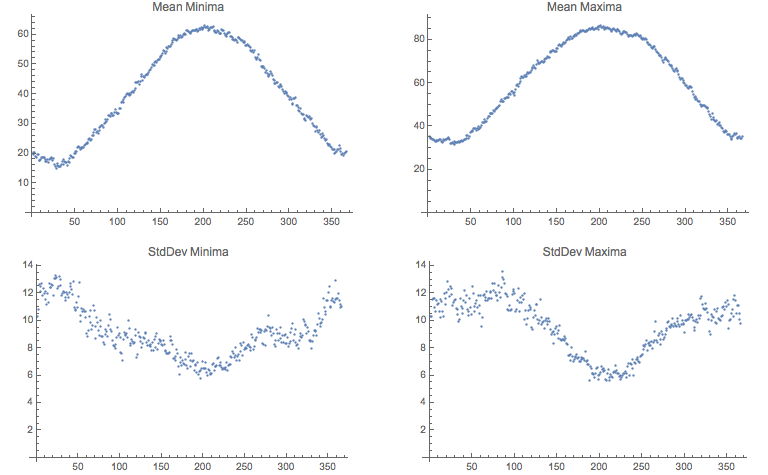
In the summer months, the deviation is lower; in the winter the deviation is higher.
- So here's what is going on: as we wind our way over the course of
the year, the max and min temperatures follow something like a
sinusoidal curve, on
average.
But only roughly like a sinusoid: so we regress with a few more periods (here's the Mathematica code, and a pdf of the output) to capture some of the dramatic wiggling in the standard deviations (in this case I used sines and cosines with terms $\cos(2\pi x), \cos(4\pi x), \ldots, \cos(12\pi x)$, and corresponding sine terms).
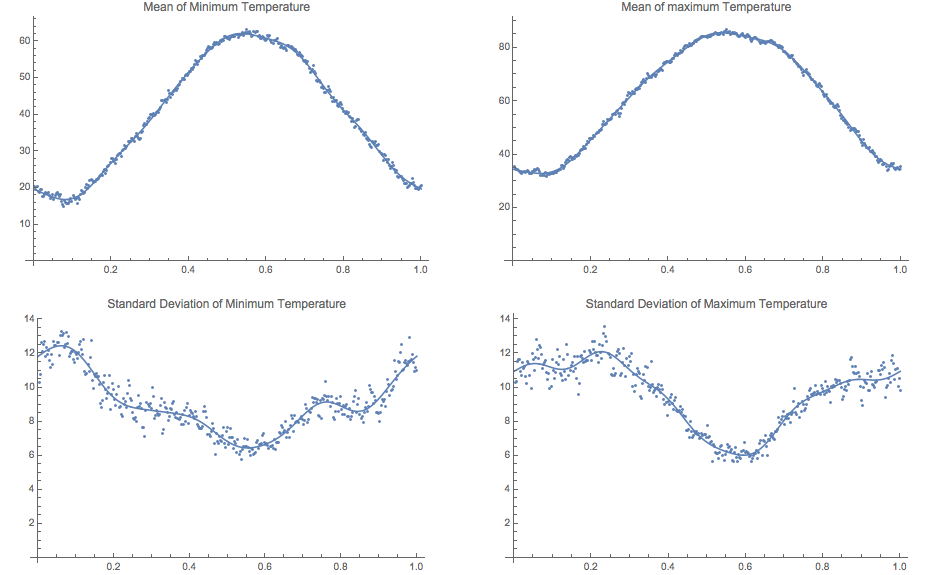
These terms correspond to the following:
$2\pi$ Period 1 year $4\pi$ Period 1/2 year $6\pi$ Period 1/3 year $8\pi$ Period 1/4 year $10\pi$ Period 1/5 year $12\pi$ Period 1/6 year Now we re-standardize the data, using these functions of time (e.g. MinMean(t), MinSD(t)), where these are annual function, with period one year: for each minimum value $min(t)$ from the BG data set, standardize it via \[ Zmin(t)=\frac{min(t)-MinMean(t)}{MinSD(t)} \]
I call it $Zmin$ because it's roughly mean 0, standard deviation 1 -- like a standard $Z$. But this $Zmin$ is still autocorrelated.
- First of all, I wanted you to look for outliers in the data. Even
though this BG data comes from NOAA, and you'd expect it to be
clean, you might be surprised at what you can find.
For example, check out 3/8/47 in the data as it arrived from NOAA.
What do you notice?
- In fact, check out each of the following dates:
1947 3 8 1957 11 13 1982 6 1 1985 2 23 1994 1 16 1994 1 19 1994 1 20 1996 6 21
- These dates were discovered by looking for places where
the DTR (Diurnal Temperature Range) was negative! That
shouldn't happened....
So we try to find anything like this -- obvious data errors -- which will cause trouble for our analysis.
- Now at this stage in my analysis I turn to the software program R,
using RStudio as the environment in which to do my work. That's because
there's a nice package called "gstat" which allows me to do the
simulations.
It has been quite the labor of love -- no, not love, but rather pain -- to trick gstat into doing what I wanted. But, in the end, it seems to have worked. gstat is designed for spatial situations, so it assumes two spatial dimensions -- so I created a constant coordinate to add to time, to trick it: $(1,1), (2,1), (3,1), \ldots, (45782,1)$.
Now I use R and RStudio to compute the variogram, and (attempt) to fit a model -- but it didn't do as well as my other software, so I did that myself and handed it to gstat. Except that we evidently disagree on some definitions, so... at any rate, I'm getting pretty close, with some educated guessin:
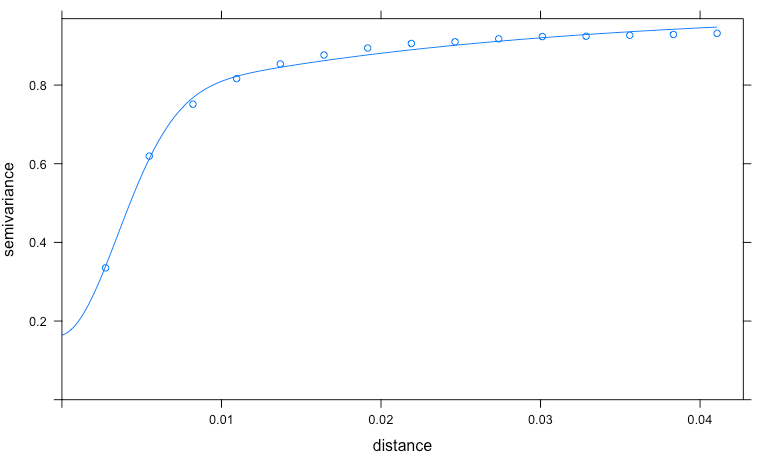
So if we're going to simulate a temperature (let's say a min), you
- Standardize the data, creating $Zmin$ as described above: \[ Zmin(t)=\frac{min(t)-MinMean(t)}{MinSD(t)} \]
- Compute the empirical variogram for $Zmin$.
- Model the empirical variogram with a theoretical variogram:

Again, just to emphasize: this is a non-linear regression problem, with a family of functions that have properties essential for the job of modeling what is essentially a variance.
- Pass that model to gstat.
- Have it generate simulations on the same dates that we
have for our data, which have the same temporal
autocorrelation structure as $Zmin$ (it's hard to tell
the difference between the one below (simulation) and
the one above (Zmin), isn't it?):
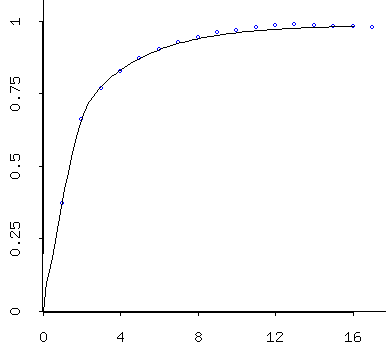
- Un-Standardize the data, creating $Smin$ by
undoing what we did to create $Zmin$, but on the
simulated data $simZmin$:
\[
Smin(t)=simZmin(t) MinSD(t) + MinMean(t)
\]
- Associate the years with this data set, as though it were
"Bowling Green temperatures"
Here's the result of regressing the simulated minima and the actual minima against $\sin(2 \pi t)$ and $\cos(2 \pi t)$:
(and, by the way, my results will be slightly different from yours, unless you too removed some erroneous data -- maybe you found some more erroneous data to remove...!:)
Linear Regression: Estimate SE Prob Constant 40.0818 (4.257565E-2) 0.00000 Variable 0 -20.4231 (6.012267E-2) 0.00000 Variable 1 -8.29364 (6.029912E-2) 0.00000 R Squared: 0.746108 Sigma hat: 9.10964 Number of cases: 45782 Degrees of freedom: 45779
simulated minima $Smin$: Mean: 40.017
SD: 18.079
Linear Regression: Estimate SE Prob Constant 40.0546 (4.318030E-2) 0.00000 Variable 0 -20.9435 (6.097651E-2) 0.00000 Variable 1 -7.24789 (6.115547E-2) 0.00000 R Squared: 0.742800 Sigma hat: 9.23901 Number of cases: 45782 Degrees of freedom: 45779
actual minima Mean: 39.993
SD: 18.217
Linear Regression: Estimate SE Prob Constant 60.6425 (4.549809E-2) 0.00000 Variable 0 -24.7985 (6.424956E-2) 0.00000 Variable 1 -9.12010 (6.443812E-2) 0.00000 R Squared: 0.787120 Sigma hat: 9.73493 Number of cases: 45782 Degrees of freedom: 45779
simulated maxima $Smax$: Mean: 60.567
SD: 21.099
Linear Regression: Estimate SE Prob Constant 60.6009 (4.605287E-2) 0.00000 Variable 0 -25.3769 (6.503299E-2) 0.00000 Variable 1 -7.87640 (6.522385E-2) 0.00000 R Squared: 0.784930 Sigma hat: 9.85363 Number of cases: 45782 Degrees of freedom: 45779actual maxima Mean: 60.530
SD: 21.247
- Compute the extreme year data (i.e. the "Fletcher data").
(to come!)
- Now do it 1000 times....
- Compare the Fletcher data to the range of possible
distributions obtained by simulation, to see how likely
(or unlikely) it would be, assuming no climate
change.
(Because our model has no climate change in it: the same means and standard deviations repeat year after year....)
- The Bestiary of functions, from Ben Bolker's Ecological Models and Data in R